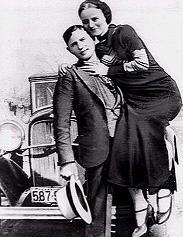Claim: Notorious criminal Clyde Barrow wrote a fan letter to Henry Ford in 1934.
Example:

Origins: America's first affordable V8-powered car was an automobile introduced in 1932 by the Ford Motor Company, one which quickly grew tremendously popular and received effusive praise from motorists. Among those enthusiastic drivers was Texas
resident Clyde Barrow, who, along with his female companion, Bonnie Parker, embarked that year on an infamous crime spree that would firmly establish the pair as American legends. Throughout a two-year period from 1932 to 1934, during which Bonnie and Clyde engaged in a string of robberies in Texas and surrounding states, Clyde Barrow repeatedly stole Ford V8 automobiles at every opportunity, as the vehicles' powerful engines, combined with Clyde's superlative driving skills, enabled the Barrow Gang to continually evade the pursuit of lawmen throughout the Midwest.
Such was Clyde Barrow's appreciation for the Ford V8 that he supposedly penned and mailed the following laudatory letter to company founder Henry Ford in April 1934:
Dear Sir: While I still have got breath in my lungs I will tell you what a dandy car you make. I have drove Fords exclusively when I could get away with one. For sustained speed and freedom from trouble the Ford has got every other car skinned, and even if my business hasen't been strickly legal it don't hurt anything to tell you what a fine car you got in the V8. Yours truly
Mr. Henry Ford
Detroit, Mich.
Clyde Champion Barrow
The letter bore a postmark indicating it was mailed from Tulsa, Oklahoma, on 10 April 1934, and it was received by Henry Ford on 13 April 1934 at his office in downtown Detroit. Ford, assuming the letter to be real, had his secretary draft a 'thank you' reply which was sent to Clyde care of General Delivery in Tulsa (although he never received it, as the Barrow Gang had headed out of Tulsa by then).
Seventy-five years later, the question remains: Was this letter (which is kept on display at the Henry Ford Museum) actually written by Clyde Barrow? Some skeptics have pointed out that its handwriting appears to be a much closer match to Bonnie Parker's than to Clyde's, but biographer Jeff Guinn notes that its contents (and the circumstances of its mailing) put its authenticity within the realm of possibility:
The letter sounds like Clyde — writing a fan letter to Henry Ford would have appealed to his sense of humor. The spelling and grammatical errors are appropriate to Clyde's limited education, and the date of the mailing and the Tulsa postmark jibe with where Clyde was at the time. But after Ford made the letter public, Clyde's family swore it wasn't authentic because of its signature — "Clyde Champion Barrow."
(Clyde Barrow's middle name was actually Chestnut. He impishly listed "Champion" as his middle name when he entered the Texas state prison at Huntsville in 1930.)
Also in early April 1934, a letter purporting to be from Clyde Barrow was sent to Amon Carter, the publisher-editor of the Fort Worth Star-Telegram, complaining about how that newspaper depicted Bonnie Parker in their coverage of the Barrow Gang's exploits. An endnote in Guinn's biography of Bonnie and Clyde indicates that he (as well as Clyde's sister) doubted the authenticity of both letters:
In print and in conversation, Marrie Barrow Scoma vehemently denied the letters to Amon Carter and Henry Ford were written by her brother. While it's fun to think they were, Marie was almost undoubtedly right. Clyde wouldn't have signed a bogus middle name to the Ford letter, and the Carter letter was mailed from the small North Texas hamlet of Decatur on a date when the Barrow Gang had fled the state for Oklahoma. Still, many historians have accepted them as Clyde's handiwork. No one will ever know for certain.
One month after the mailing of the reputed Clyde Barrow letter to Henry Ford, a quirky repetition occurred when the Ford Motor Company announced it had received the following letter, dated
Bye-bye,
Hello Old Pal. Arrived here at 10:00 AM today. Would like to drop in and see you. You have a wonderful car. Been driving it for weeks. It's a treat to drive one. Your slogan should be, drive a Ford and watch the other cars fall behind you. I can make any other car take a Ford's dust!
John Dillinger
Unlike the Barrow letter, this latter missive was conclusively demonstrated to be a forgery when it was compared with earlier
samples of Dillinger's handwriting.

(The hoax was probably based on the mistaken notion that Dillinger had been part of the gang who held up the Citizens Commercial Savings Bank in Flint, Michigan, on
The high quality and speed of Ford Motor Company automobiles extolled in these criminals' letters did not enable them to survive much longer, however. Despite the legendary driving skills that helped John Dillinger elude capture time and again, he was gunned down by FBI agents while walking outside the Biograph Theater in Chicago just
Barbara "184 bullet holes — wow, he shouldn't have had a V8" Mikkelson
Last updated: 12 October 2009
Sources: |
Guinn, Jeff. Go Down Together: The True, Untold Story of Bonnie and Clyde. New York: Simon and Schuster, 2009. ISBN 1-4165-5706-7 (pp. 297-299). Matera, Dary. John Dillinger: The Life and Death of America's First Celebrity Criminal. Cambridge, MA: Da Capo Press, 2004. ISBN 0-7867-1354-2 (p. 260). Nash, Jay Robert and Ron Offen. Dillinger: Dead or Alive? Chicago: Henry Regnery Company, 1970 (pp. 54-55). Library of Curious and Unusual Facts. Crimes and Punishments. Virginia: Time-Life Books, 1991. ISBN 0-8094-7727-0 (p. 123).
